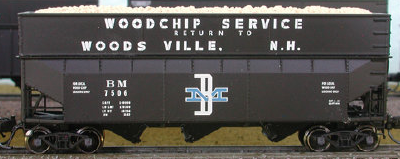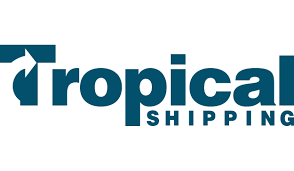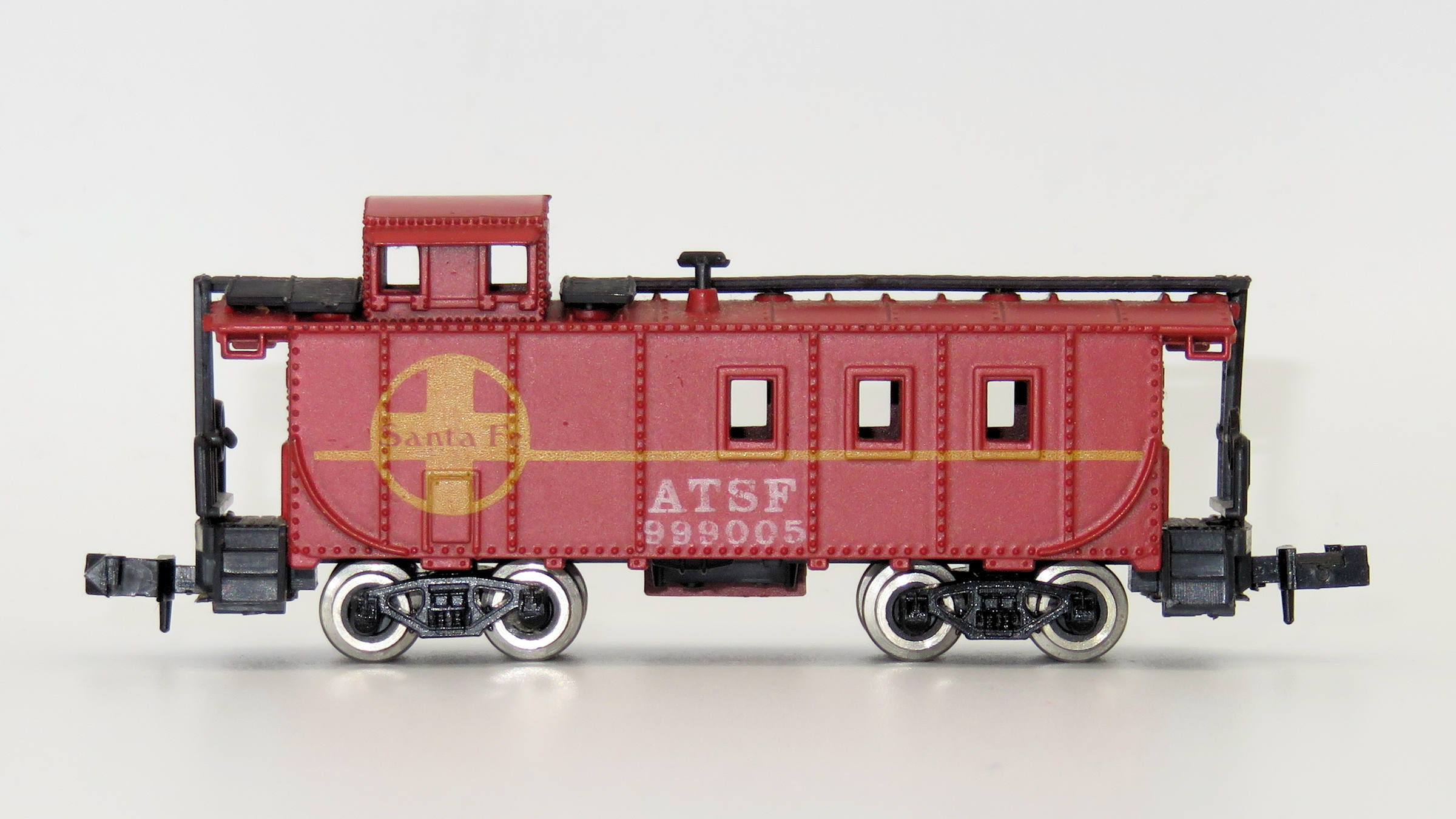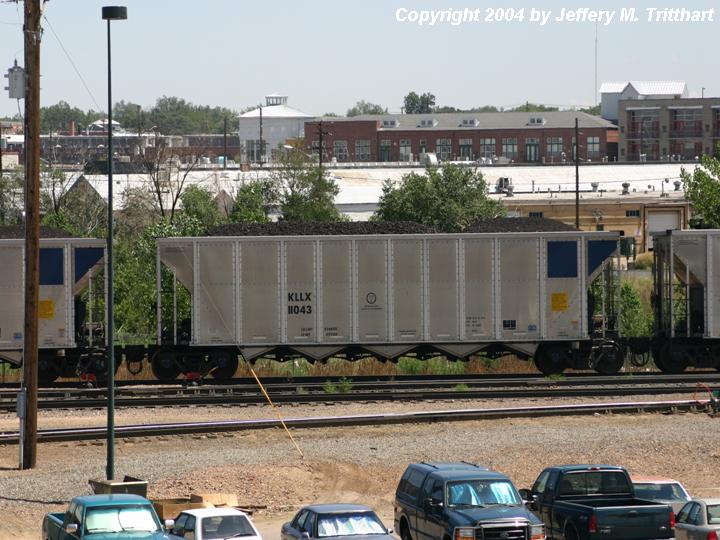Model Information: This Fox Valley model was actually designed by Fox Valley and not acquired from another vendor such as their 5-Bay Ortner model. It is an excellent model; it has good detail and excellent printing. The body mount couplers and high quality chemically blackened low-profile wheels are both nice features. Also, as expected, they have the world-class Fox Valley blackened metal wheels, known to have accurate proportions as well as running smoothly and relatively quietly.
The one thing they got wrong is the cheesy load. It looks like they studied the loads from the Red Caboose/Precision Masters models that they acquired and decided "well if modelers will settle for that, I guess we don't need to work very hard to make something better". And that is what they got - something that is not better, but should be. Fortunately with a little patience you can remove the factory loads and put your own in. They are not glued in.
The one thing they got wrong is the cheesy load. It looks like they studied the loads from the Red Caboose/Precision Masters models that they acquired and decided "well if modelers will settle for that, I guess we don't need to work very hard to make something better". And that is what they got - something that is not better, but should be. Fortunately with a little patience you can remove the factory loads and put your own in. They are not glued in.
Prototype History: The 1960s brought about a growth in car size (and capacity). Railroads that transported coal moved away from the older 2-bay 55-ton USRA standard to newer railcars. The Trinity RD IV (or RD-4) has a 4200 cubic foot capacity and is principally used for coal. They are 53 foot 1inches long. And have been used by power plants as well as commercial railroads. The cars are recognizable from their alternating six-thin-and-five-thick exterior post pattern. Information about this railcar can be found in the Simmons-Boardman 1997 Car & Locomotive Cyclopedia.
Road Name History: 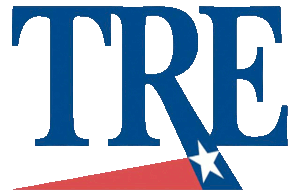 The Trinity Railway Express (or TRE) is a commuter rail line in the Dallas?Fort Worth metroplex. It was established by an interlocal agreement between Dallas Area Rapid Transit (DART) and the Fort Worth Transportation Authority (The T). Each transit authority owns a 50% stake in the joint rail project and contractor Herzog Transit Services operates the line. The TRE began operating in December 1996.
The Trinity Railway Express (or TRE) is a commuter rail line in the Dallas?Fort Worth metroplex. It was established by an interlocal agreement between Dallas Area Rapid Transit (DART) and the Fort Worth Transportation Authority (The T). Each transit authority owns a 50% stake in the joint rail project and contractor Herzog Transit Services operates the line. The TRE began operating in December 1996.
As of the fourth quarter of 2014, the TRE has an average weekday ridership of 8,200 passengers per day and is the fifteenth most-ridden commuter rail system in the United States. In 2014, the TRE carried 2,293,500 passengers.
Before 2006, the TRE was typically shown as a green line on DART maps and therefore was sometimes referred to as the "Green Line," but this was not an official designation. In 2006, DART chose green as the color for its new light rail route, the Green Line. Since 2006, the TRE has been shown as a dark blue line on DART maps.
Named after the Trinity River, which flows between Fort Worth and Dallas, the TRE was launched on December 30, 1996, shortly after the inaugural service of Dallas' DART Light Rail system, operating from Union Station to the South Irving Station in Irving. On September 18, 2000, the line was extended to the Richland Hills Station and, for the first time, there was rail service available between downtown Dallas and DFW Airport. On November 13, 2000 the West Irving Station also opened. On December 3, 2001, the TRE was extended to its current terminus at the T&P Station in downtown Fort Worth.

As of the fourth quarter of 2014, the TRE has an average weekday ridership of 8,200 passengers per day and is the fifteenth most-ridden commuter rail system in the United States. In 2014, the TRE carried 2,293,500 passengers.
Before 2006, the TRE was typically shown as a green line on DART maps and therefore was sometimes referred to as the "Green Line," but this was not an official designation. In 2006, DART chose green as the color for its new light rail route, the Green Line. Since 2006, the TRE has been shown as a dark blue line on DART maps.
Named after the Trinity River, which flows between Fort Worth and Dallas, the TRE was launched on December 30, 1996, shortly after the inaugural service of Dallas' DART Light Rail system, operating from Union Station to the South Irving Station in Irving. On September 18, 2000, the line was extended to the Richland Hills Station and, for the first time, there was rail service available between downtown Dallas and DFW Airport. On November 13, 2000 the West Irving Station also opened. On December 3, 2001, the TRE was extended to its current terminus at the T&P Station in downtown Fort Worth.
Brand/Importer Information: Fox Valley Models is a small supplier of
model railroad and related products. FVM
started by finding solutions to different
challenges that model railroaders were
faced with. Our first products resulted
from a need to equip custom built
passenger cars with tinted windows made
of an ideal material; thin, flexible, easy to
cut, simple to install, available in multiple
colors and be affordable. We met those
needs and even included a frosted
version for the car's lavatory windows.
Other challenges inspired additional products including wooden grade crossings, trestles and different lineside structures. As our product line expands, input and requests from friends and customers help shape the product selection further.
Future products, under development, include more parts, structures, details and rolling stock. We strive to offer a good quality product at an affordable price.
Other challenges inspired additional products including wooden grade crossings, trestles and different lineside structures. As our product line expands, input and requests from friends and customers help shape the product selection further.
Future products, under development, include more parts, structures, details and rolling stock. We strive to offer a good quality product at an affordable price.
Item created by: CNW400 on 2022-07-02 09:06:56. Last edited by CNW400 on 2022-07-02 12:30:37
If you see errors or missing data in this entry, please feel free to log in and edit it. Anyone with a Gmail account can log in instantly.
If you see errors or missing data in this entry, please feel free to log in and edit it. Anyone with a Gmail account can log in instantly.






